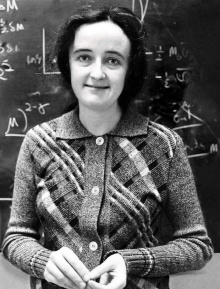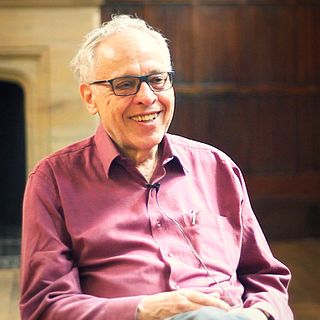
Sir Fred Hoyle (24 June 1915 – 20 August 2001) was an English astronomer who formulated the theory of stellar nucleosynthesis and was one of the authors of the influential B2FH paper. He also held controversial stances on other scientific matters—in particular his rejection of the "Big Bang" theory (a term coined by him on BBC Radio) in favor of the "steady-state model", and his promotion of panspermia as the origin of life on Earth. He spent most of his working life at St John's College, Cambridge and served as the founding director of the Institute of Theoretical Astronomy at Cambridge.

Sandra Moore Faber is an American astrophysicist known for her research on the evolution of galaxies. She is the University Professor of Astronomy and Astrophysics at the University of California, Santa Cruz, and works at the Lick Observatory. She has made discoveries linking the brightness of galaxies to the speed of stars within them and was the co-discoverer of the Faber–Jackson relation. Faber was also instrumental in designing the Keck telescopes in Hawaii.
George Ogden Abell was an American astronomer and professor. He taught at UCLA, primarily as a research astronomer. He earned his B.S. in 1951, his M.S. in 1952 and his Ph.D. in 1957, all from Caltech. He was a Ph.D. student under Donald Osterbrock. His astronomy career began as a tour guide at the Griffith Observatory in Los Angeles. Abell made great contributions to astronomical knowledge which resulted from his work during and after the National Geographic Society - Palomar Observatory Sky Survey, especially concerning clusters of galaxies and planetary nebulae. A galaxy, an asteroid, a periodic comet, and an observatory are all named in his honor. His teaching career extended beyond the campus of UCLA to the high school student oriented Summer Science Program, and educational television. He not only taught about science but also about what is not science. He was an originating member of the Committee on Scientific Investigation of Claims of the Paranormal now known as the Committee for Skeptical Inquiry.

The Astronomical Society of the Pacific (ASP) is an American scientific and educational organization, founded in San Francisco on February 7, 1889, immediately following the solar eclipse of January 1, 1889. Its name derives from its origins on the Pacific Coast, but today it has members all over the country and the world. It has the legal status of a nonprofit organization.

John David Barrow was an English cosmologist, theoretical physicist, and mathematician. He served as Gresham Professor of Geometry at Gresham College from 2008 to 2011. Barrow was also a writer of popular science and an amateur playwright.

Beatrice Muriel Hill Tinsley was a British-born New Zealand astronomer and cosmologist, and the first female professor of astronomy at Yale University, whose research made fundamental contributions to the astronomical understanding of how galaxies evolve, grow and die.

Virginia Louise Trimble is an American astronomer specializing in the structure and evolution of stars and galaxies, and the history of astronomy. She has published more than 600 works in Astrophysics, and dozens of other works in the history of other sciences. She is famous for an annual review of astronomy and astrophysics research that was published in the Publications of the Astronomical Society of the Pacific, and often gives summary reviews at astrophysical conferences. In 2018, she was elected a Patron of the American Astronomical Society, for her many years of intellectual, organizational, and financial contributions to the society.

Philip Morrison was a professor of physics at the Massachusetts Institute of Technology (MIT). He is known for his work on the Manhattan Project during World War II, and for his later work in quantum physics, nuclear physics, high energy astrophysics, and SETI.

Edwin Charles Krupp is an American astronomer, researcher, author, and popularizer of science. He is an internationally recognized expert in the field of archaeoastronomy, the study of how ancient cultures viewed the sky and how those views affected their cultures. He has taught at the college level, as a planetarium lecturer, and in various documentary films. He has been the director of the Griffith Observatory in Los Angeles since first taking over the position in 1974 after the departure of the previous director, William J. Kaufmann III. His writings include science papers and journal articles, astronomy magazine articles, books on astronomy and archaeoastronomy for adults, and books explaining sky phenomena and astronomy to children.

Joseph Ivor Silk is a British-American astrophysicist. He was the Savilian Chair of Astronomy at the University of Oxford from 1999 to September 2011.

Foothill Observatory is an astronomical observatory owned and operated by Peninsula Astronomical Society (PAS) and Foothill College. It is located on the college's campus in Los Altos Hills, California (US). The observatory is used by students enrolled in the introductory astronomy lab on campus, which is part of the college's thriving astronomy for non-scientists program, serving over 800 students per year. A 16-inch (410 mm) Schmidt-Cassegrain telescope was donated to the observatory and went into operation in 2007.

Margaret J. Geller is an American astrophysicist at the Center for Astrophysics | Harvard & Smithsonian. Her work has included pioneering maps of the nearby universe, studies of the relationship between galaxies and their environment, and the development and application of methods for measuring the distribution of matter in the universe.

Ron Miller is an American illustrator and writer who lives and works in South Boston, Virginia. He now specializes in astronomical, astronautical and science fiction books for adults and young adults.

Alexei Vladimir "Alex" Filippenko is an American astrophysicist and professor of astronomy at the University of California, Berkeley. Filippenko graduated from Dos Pueblos High School in Goleta, California. He received a Bachelor of Arts in physics from the University of California, Santa Barbara in 1979 and a Ph.D. in astronomy from the California Institute of Technology in 1984, where he was a Hertz Foundation Fellow. He was a postdoctoral Miller Fellow at Berkeley from 1984 to 1986 and was appointed to Berkeley's faculty in 1986. In 1996 and 2005, he was a Miller Research Professor, and he is currently a Senior Miller Fellow. His research focuses on supernovae and active galaxies at optical, ultraviolet, and near-infrared wavelengths, as well as on black holes, gamma-ray bursts, and the expansion of the Universe.
The Gordon Myers Amateur Achievement Award, known until 2018 as the Amateur Achievement Award of the Astronomical Society of the Pacific, is one of nine annual astronomical awards managed by the Astronomical Society of the Pacific. It recognizes "significant contributions to astronomy or amateur astronomy by those not employed in the field of astronomy in a professional capacity." The contributions can be done in the fields of both observational astronomy or astronomical technologies. The award has been given to amateur astronomers from various countries since 1979 and has become one of the most geographically diverse astronomical awards.

Michael David Reynolds was an American author and educator who served as professor of astronomy at Florida State College at Jacksonville in Jacksonville, Florida. He served as the director of Chabot Space and Science Center in Alameda County, California. Reynolds was best known for his work in science education, both in lecture halls and less formal settings. He also participated in astronomy and space exploration outreach.

Andrew Christopher Fabian is a British astronomer and astrophysicist. He was Director of the Institute of Astronomy, University of Cambridge from 2013 to 2018. He was a Royal Society Research Professor at the Institute of Astronomy, Cambridge from 1982 to 2013, and Vice-Master of Darwin College, Cambridge from 1997 to 2012. He served as president of the Royal Astronomical Society from May 2008 through to 2010.
Stephen P. Maran is an American astronomer and popularizer who is known for his books, articles, and popular lectures for the general public, including Astronomy For Dummies.
The Carl Sagan Prize for Science Popularization is an annual $5,000 award presented in honor of the late scientist Carl Sagan by Wonderfest, the San Francisco Bay Area Beacon of Science, to a scientist who has "contributed mightily to the public understanding and appreciation of science."

Sidney Carne Wolff is an American astrophysicist, researcher, public educator, and author. She is the first woman in the United States to head a major observatory, and she provided significant contributions to the construction of six telescopes. Wolff served as Director of the Kitt Peak National Observatory (KPNO) and the National Optical Astronomy Observatory (NOAO). She is a member of the International Astronomical Union's Division G: Stars and Stellar Physics.

















